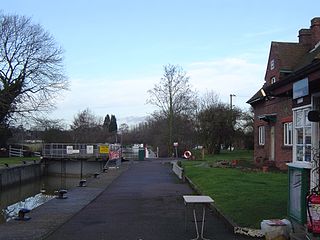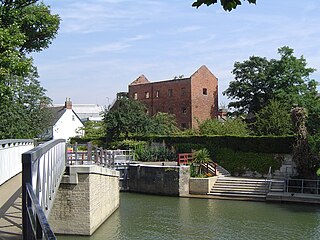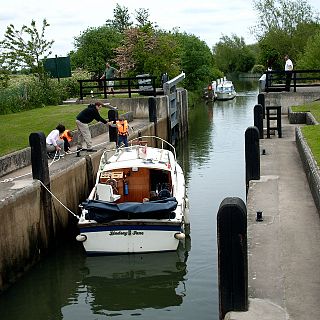| Tenfoot Bridge | |
|---|---|
 | |
| Coordinates | 51°41′39″N1°29′24″W / 51.694223°N 1.489891°W Coordinates: 51°41′39″N1°29′24″W / 51.694223°N 1.489891°W |
| Carries | Footpath |
| Crosses | River Thames |
| Locale | Oxford |
| Characteristics | |
| Material | Wood |
| Height | 12 feet 2 inches (3.71 m) |
| No. of spans | 1 |
| History | |
| Opened | 1869 |
Tenfoot Bridge is a wooden footbridge across the River Thames in Oxfordshire, England. It is situated on the reach above Shifford Lock and was built in 1869. It connects Buckland on the south bank to Chimney on the north.

The River Thames, known alternatively in parts as the Isis, is a river that flows through southern England including London. At 215 miles (346 km), it is the longest river entirely in England and the second longest in the United Kingdom, after the River Severn.

Oxfordshire is a county in South East England. The ceremonial county borders Warwickshire to the north-west, Northamptonshire to the north-east, Buckinghamshire to the east, Berkshire to the south, Wiltshire to the south-west and Gloucestershire to the west.
Shifford Lock is a lock on the River Thames in England. It is in the centre of a triangle formed by the small villages of Shifford, Duxford and Chimney in Oxfordshire. It is at the start of a navigation cut built with the lock by the Thames Conservancy in 1898. It replaced a flash lock in a weir about 3/4 mile downstream.
The name derives from a pre-existing weir which had a 10-foot-wide flash lock (3.0 m) in it. In 1867 there were complaints about the state of the weir bridge and after a dispute, the Thames Conservancy removed the weir and built the bridge two years later. [1]

Early locks were designed with a single gate, known as a flash lock or staunch lock. The earliest European references to what were clearly flash locks were in Roman times.

The Thames Conservancy was a historical body responsible for the management of the River Thames in England. It was founded in 1857, initially replacing the jurisdiction of the City of London up to Staines and later taking responsibility for the whole river from Cricklade in Wiltshire to the sea at Yantlet Creek on the Isle of Grain. Responsibilities were reduced when the Tideway was transferred to the Port of London Authority in 1909 and in 1974 the Conservancy was taken into the Thames Water Authority.
The Thames Path passes the bridge on the north bank, but does not cross it. The path formerly crossed the bridge to Duxford south of the old course of the Thames.

The Thames Path is a National Trail following the River Thames from its source near Kemble in Gloucestershire to the Thames Barrier at Charlton, south east London. It is about 184 miles (296 km) long. A path was first proposed in 1948 but it only opened in 1996.

Duxford is a hamlet in the civil parish of Hinton Waldrist 5.5 miles (9 km) northeast of Faringdon. It was part of Berkshire until the 1974 boundary changes transferred it to Oxfordshire. It is on the south bank of the River Thames, where there is a ford leading to Chimney on the north bank.















